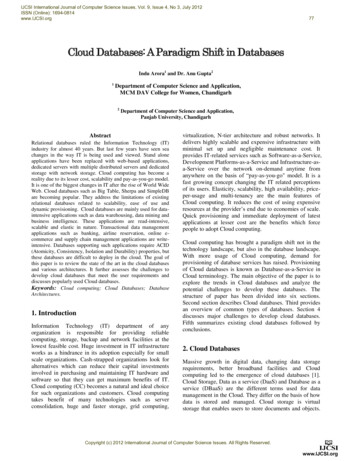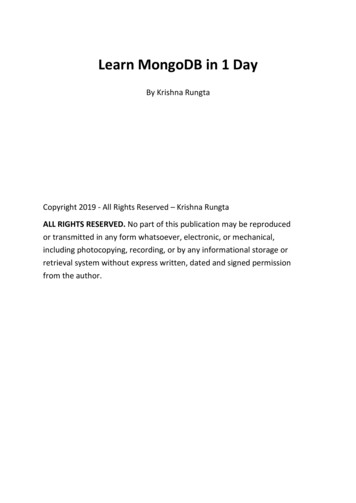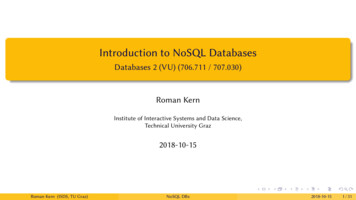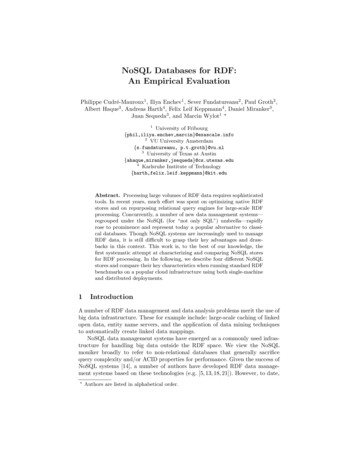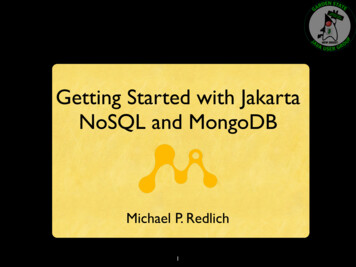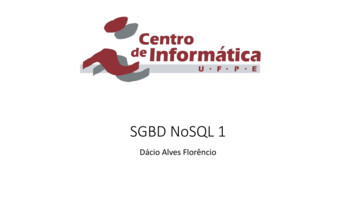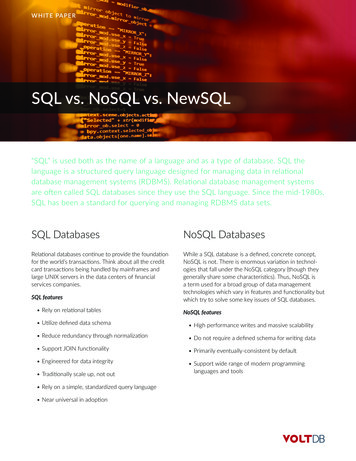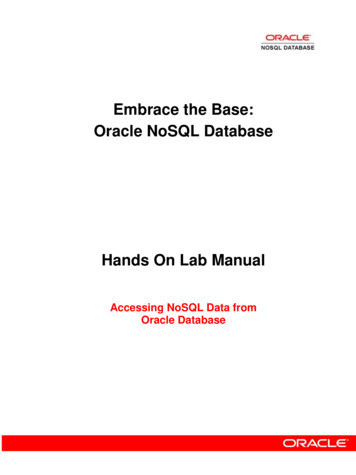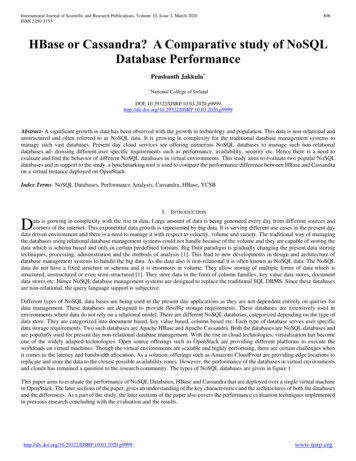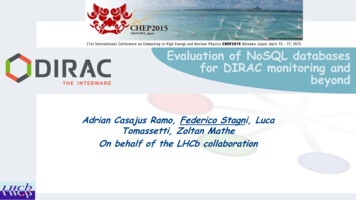
Transcription
Evaluation of NoSQL databasesfor DIRAC monitoring andbeyondAdrian Casajus Ramo, Federico Stagni, LucaTomassetti, Zoltan MatheOn behalf of the LHCb collaboration
Motivation Develop a system for real time monitoring and data analysis: Requirements Focus on monitoring the jobs (not accounting)Optimized for time series analysisEfficient data storage, data analysis and retrievalEasy to maintainScale HorizontallyEast to create complex reports (dashboards)Why? Current system is based on MySQL: is not designed for real time monitoring (more for accounting)does not scale to hundred of million rows ( 500 million). It requires 400 second to generate a one-month duration plotis not for real time analysisis not schema-less: Often change the data formatEvaluation of NoSQL databases for DIRAC monitoring and beyond, CHEP20152
MotivationEvaluation of NoSQL databases for DIRAC monitoring and beyond, CHEP20153
Technologies used Database: InfluxDB is a distributed time series database with no dependencyOpenTSDB is a distributed time series database based on HBaseElasticSearch is a distributed search and analytic engineData visualization: Grafana Metric dashboard and graph editor for InfluxDB, Graphite and OpenTSDBEvaluation of NoSQL databases for DIRAC monitoring and beyond, CHEP20154
Motivation Grafana dashboard:Evaluation of NoSQL databases for DIRAC monitoring and beyond, CHEP20155
Technologies used Database: InfluxDB is a distributed time series database with no dependencyOpenTSDB is a distributed time series database based on HBaseElasticSearch is a distributed search and analytic engineData visualization: Grafana Metric dashboard and graph editor for InfluxDB, Graphite and OpenTSDKibana Flexible analytic and visualization frameworkDeveloped for creating complex dashboardsEvaluation of NoSQL databases for DIRAC monitoring and beyond, CHEP20156
Technologies used Kibana dashboard:Evaluation of NoSQL databases for DIRAC monitoring and beyond, CHEP20157
Technologies used Database: InfluxDB is a distributed time series database with no dependenciesOpenTSDB is a distributed time series database based on HBaseElasticSearch is a distributed search and analytic engineData visualization: Grafana Kibana Metric dashboard and graph editor for InfluxDB, Graphite and OpenTSDFlexible analytic and visualization frameworkDeveloped for creating complex dashboardsCommunication RabbitMQ Robust messaging systemEvaluation of NoSQL databases for DIRAC monitoring and beyond, CHEP20158
Overview of the SystemEvaluation of NoSQL databases for DIRAC monitoring and beyond, CHEP20159
Hardware and data format RabbitMQ 12 VMs provided by CERN OpenStack one physical machineEach VM has 4 core, 8 GB memory and 80GB diskWe used 3 clusters with 4 nodesData format: The records are sent to the RabbitMQ in JSON format.Each record must contain a minimum of four elements: metric, time, key/value pairs, valueFor example: {"Status": "Done", ”time": 1404086442, "JobSplitType": "MCSimulation","MinorStatus": "unset", "Site": "ARC.Oxford.uk", "value": 10, ”metric": ”WMSHistory","User": "phicharp", "JobGroup": "00037468", "UserGroup": "lhcb mc”}Evaluation of NoSQL databases for DIRAC monitoring and beyond, CHEP201510
Performance comparison We have recorded 600 million records during 1.5 monthWe defined 5 different queries Running jobs grouped by SiteRunning jobs grouped by JobGroupRunning jobs grouped by JobSplitTypeFailed jobs grouped by JobSplitTypeWaiting jobs grouped by JobSplitTypeQuery intervals: 1, 2, 7 and 30 day Random interval: Start and end time are generated randomly between 2015-02-05, 15:00:00 and 2015-03-1215:00:00The high workload is generated by 10, 50, 100 clients (python threads) tomeasure the response time and the throughput REST APIs are used to retrieve the data from the DBAll clients are used a random query and a random periodAll clients are continuously running parallel during 7200 secondEvaluation of NoSQL databases for DIRAC monitoring and beyond, CHEP201511
Results: 10 clientEvaluation of NoSQL databases for DIRAC monitoring and beyond, CHEP201512
Results: 50 clientEvaluation of NoSQL databases for DIRAC monitoring and beyond, CHEP201513
Results: 100 clientEvaluation of NoSQL databases for DIRAC monitoring and beyond, CHEP201514
Response time of all experimentsEvaluation of NoSQL databases for DIRAC monitoring and beyond, CHEP201515
Throughput of all experimentsEvaluation of NoSQL databases for DIRAC monitoring and beyond, CHEP201516
Conclusions ElasticSearch was faster than OpenTSDB and InfluxDB It is easy to maintainMarvel is a very good tool for monitoring the cluster It can be easily integrated to the DIRAC portalOpenTSDB was slower than ElasticSearch but it may scale better by adding morenodes to the cluster It is not easy to maintain (lot of parameters which have to be correctly set)Very good monitoring of the cluster.InfluxDB is a new time series database, which is easy to use, but it does notscaleKibana can fulfil our needs license required But we’ll look at integration in the DIRAC portalAccording to our experience we decided to use ElasticSerach for real timemonitoring of jobs, and for all real time DIRAC monitoring systemsEvaluation of NoSQL databases for DIRAC monitoring and beyond, CHEP201517
Thanks!Question, comments?Evaluation of NoSQL databases for DIRAC monitoring and beyond, CHEP201518
Technologies used Evaluation of NoSQL databases for DIRAC monitoring and beyond, CHEP2015 6 Database: InfluxDB is a distributed time series database with no dependency OpenTSDB is a distributed time series database based on HBase ElasticSearch is a distributed search and analytic engine Data visualization: Grafana Metric dashboard and graph editor for InfluxDB, Graphite and OpenTSD
